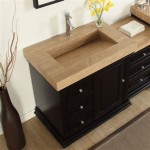Do Bathroom Vanities Need To Match Kitchen Cabinets?
The question of whether bathroom vanities need to match kitchen cabinets is a common one in home design and renovation. There is no absolute rule dictating that they must, and ultimately the decision rests on individual preferences and the overall aesthetic goal for the home. However, considering the relationship between these two spaces and the impact of their design choices on the home's overall flow and value is crucial. This article will explore various factors to contemplate when deciding whether to coordinate the design of bathroom vanities and kitchen cabinets.
The concept of "matching" can be interpreted in different ways. It might imply an exact replication of cabinet style, color, and hardware. Alternatively, it could refer to a more subtle coordination through complementary materials, similar design themes, or a shared color palette. Understanding these different levels of "matching" is essential before making a decision.
Considering the Proximity and Visibility of the Spaces
One of the primary factors to consider is the proximity of the kitchen and bathrooms within the home’s layout. In open-concept homes, where the kitchen seamlessly flows into the living area, and potentially even has sightlines to a powder room or adjacent bathroom, the design choices in one space will inevitably impact the perception of the other. In such cases, a more coordinated approach can create a sense of continuity and harmony throughout the living space.
Conversely, in homes where the kitchen and bathrooms are located on different floors or separated by significant hallways, the need for strict coordination is less critical. In these situations, more freedom exists to explore distinct design styles in each space, allowing for more personalized and expressive design choices. Even in these situations, though, a unifying element, such as the overall design aesthetic (e.g., modern, traditional, rustic), may be considered to maintain some level of coherence throughout the home.
The level of visibility between the spaces also plays a significant role. If a guest bathroom is directly across from the kitchen, visual consistency becomes more important to avoid a jarring transition between the two. However, if the bathroom is tucked away and not immediately visible from the kitchen, there is more latitude to deviate from the kitchen's design scheme.
Ultimately, analyzing the floor plan and the visual relationship between the kitchen and bathrooms is a crucial first step in determining the appropriate level of coordination between the cabinetry.
Analyzing the Overall Design Style and Theme
The existing or desired overall design style of the home is another key factor. Homes with a strong architectural style (e.g., mid-century modern, Victorian, farmhouse) often benefit from consistent design choices throughout, including the kitchen and bathrooms. Maintaining a consistent design theme enhances the perceived value and cohesiveness of the property.
For example, in a mid-century modern home, sleek, minimalist kitchen cabinets would be complemented by equally streamlined bathroom vanities. Using similar hardware, materials, and color palettes would further reinforce the design theme. Introducing a drastically different style in the bathroom, such as ornate Victorian-style vanities, could disrupt the overall aesthetic and create a sense of disharmony.
Similarly, a farmhouse-style home with rustic wooden kitchen cabinets would generally benefit from bathroom vanities that incorporate similar materials and design elements. Distressed wood finishes, shaker-style doors, and vintage-inspired hardware could be used to maintain the farmhouse aesthetic throughout the home.
However, even within a specific design style, there is room for variation and personalization. The key is to ensure that the design choices in the kitchen and bathrooms complement each other and contribute to the overall aesthetic rather than clashing or feeling out of place.
Furthermore, consider the target market if selling the home is a future possibility. Broadly appealing design choices that maintain a cohesive aesthetic will generally increase the home's market value and appeal to a wider range of potential buyers. Highly personalized or unconventional design choices may limit the home's appeal and potentially decrease its value.
Considering Practical and Budgetary Constraints
Practical considerations and budgetary constraints also influence the decision-making process. Coordinating kitchen cabinets and bathroom vanities may be achieved in various ways, ranging from custom-made cabinetry to off-the-shelf options. Custom cabinetry offers the greatest flexibility in terms of design and materials, but it is also the most expensive option.
If budget is a primary concern, exploring semi-custom or stock cabinetry options is advisable. These options offer a range of styles and finishes at a more affordable price point. While the selection may be more limited compared to custom cabinetry, it is often possible to find suitable options that complement the kitchen design without exceeding the budget.
Material choices also play a significant role in budget considerations. Solid wood cabinetry is generally more expensive than engineered wood options such as plywood or MDF (Medium-Density Fiberboard). However, solid wood may offer superior durability and longevity, making it a worthwhile investment in the long run. The intended use of the bathroom is also a factor. A high-use family bathroom may benefit from a more durable, water-resistant material than a rarely used guest bathroom.
Furthermore, the size and configuration of the bathroom may limit the available options. Small bathrooms may require compact vanities with limited storage space. In such cases, prioritizing functionality and space efficiency is essential. Large bathrooms, on the other hand, may offer more flexibility in terms of vanity size and design.
Beyond the cabinets themselves, consider the countertops, sinks, faucets, and hardware. Coordinating these elements can further enhance the overall design and create a more cohesive look. For example, using the same type of countertop material (e.g., granite, quartz, marble) in both the kitchen and bathrooms can create a sense of continuity throughout the home.
The practical limitations of each space should also be kept in mind. Kitchens require more work surfaces and storage than bathrooms, so the design must reflect these practical needs. Bathrooms need to be designed to cope with humidity, so water-resistant materials are more important than in kitchens. Making sure that cabinets are suitable for the environment will increase their lifespan.
Ultimately, the decision of whether or not to coordinate kitchen cabinets and bathroom vanities should be based on a careful consideration of the aesthetic goals, the overall design style of the home, the proximity and visibility of the spaces, and the budgetary and practical constraints. While strict matching is not always necessary, a coordinated approach can enhance the overall design and create a more cohesive and harmonious living environment.
Seeking professional advice from an interior designer or contractor can be beneficial, especially when undertaking a major renovation project. A professional can provide valuable insights and guidance on design choices, material selection, and budget management, helping to create a cohesive and functional space that reflects individual preferences and enhances the home's value.
It is important to remember that design trends can change over time. While it is important to stay informed about current trends, it is equally important to choose design elements that are timeless and reflect personal style. Investing in high-quality materials and craftsmanship will ensure that the kitchen and bathrooms remain stylish and functional for many years to come.

Bathroom Kitchen Do They Need To Match Virginia Bath

Vanities Furniture Style Vs Traditional Cabinet Toulmin Kitchen Bath Custom Cabinets Kitchens And Bathroom Design Remodeling In Tuscaloosa Birmingham Alabama

Choose Your Bathroom Vanity With These 7 Simple Steps

What Is The Difference Between Kitchen And Bathroom Cabinets

What Is The Difference Between Kitchen And Bathroom Cabinets

Should My Kitchen And Bathroom Cabinets Match

How To Use Cabinets Organize Your Bathroom

Do Bathroom Vanities Need To Match Kitchen Cabinets

6 Modern Bathroom Vanity Design Ideas Lily Ann Cabinets

Bathroom Vanity Vs Cabinet Is There A Difference
Related Posts







